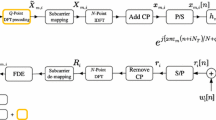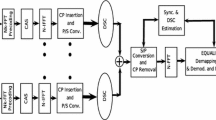Abstract
Orthogonal frequency division multiple access (OFDMA) is a multi-carrier, multiple access (MA) technique, which is widely adopted in contemporary wireless standards. Single carrier-frequency division multiple access (SC-FDMA) is a modified version of OFDMA which employs single carrier transmission by pre-coding the data symbols using discrete Fourier transform (DFT). However, these systems are highly vulnerable to the adverse effects arising in the channel, carrier frequency offset (CFO) and in-phase/quadrature phase (I/Q) imbalances. In the uplink communication scenario, the signal received at base station is the superposition of signals from all the active users. Even though the adverse effects caused by the communication channel and CFOs are addressed in the related literature extensively, the effect of I/Q-imbalances at the transmitter and the receiver is rarely considered. The effect of I/Q-imbalances will make the equalization process at the base station more complex. It is because the overall effective channel with radio impairments must be included in the system modelling. Hence the receiver processing should contain the equalization for effect of the channel, CFOs and I/Q imbalances. In this paper, we propose a novel technique based on the oblique projection (OP) technique for equalizing the channel, radio imbalances and synchronization errors caused by both transmitter (TX) and receiver (RX) for OFDMA/SC-FDMA uplink systems. We also propose an equalization technique with reduced computational complexity to overcome the adverse effects caused by I/Q imbalances and CFOs. The results of the simulation studies illustrate that the proposed techniques can compensate all the above-mentioned effects and they offer very good performance under both TX and RX I/Q imbalances.





Similar content being viewed by others
Availability of Data and Material
The datasets supporting the results of this article are included within the article.
Code Availability
The code generated during and/or analysed during the current study are available from the corresponding author on reasonable request.
References
Yin, H., & Alamouti, S. (2006). OFDMA: A broadband wireless access technology. In IEEE Sarnoff Symposium (pp. 1–4).
Anoop, C. V., Bhaskar, V., & Nithya, V. (2021). Lower complex resource allocation methodology based on graph theory and index matrix rearrangement for OFDMA/MIMO-OFDMA systems. Wireless Personal Communications, 118(4), 2253–2277.
Myung, H. G., Junsung, L., & Goodman, D. J. (2006). Peak-to-average power ratio of single carrier FDMA signal with pulse sahping. The 17th annual IEEE international symposium on personal, indoor and mobile radio communications (PIMRC’06) (pp. 1–5).
Ng, B., Lam, C. T., & Falconer, D. (2007). Turbo frequency domain equalization for single-carrier broadband wireless systems. IEEE Transactions on Wireless Communications, 6(2), 759–767.
Hakkarainen, A., Werner, J., Dandekar, K. R., & Valkama, M. (2014). Precoded massive MU-MIMO uplink transmission under transceiver I/Q imbalance. In 2014 IEEE Globecom Workshops. (GC Wkshps) vol. 2014, (pp. 320–326).
Heo, J., Cha, I., & Chang, K. (2007). Effective adaptive transmit power allocation algorithm considering dynamic channel allocation in reuse partitioning-based OFDMA system. Wireless Personal Communications, 43(2), 677–684.
Poveda, H., Ferré, G., & Grivel, E. (2013). A non-pilot aided iterative carrier frequency offset estimator using optimal filtering for an interleaved OFDMA uplink system. Wireless Personal Communications, 68(3), 747–767.
Boulogeorgos, A. A. A., Diamantoulakis, P. D., & Karagiannidis, G. K. (2016). Optimal power allocation for OFDMA systems under I/Q imbalance. IEEE Signal Processing Letters, 23(11), 1677–1681.
Gazda, J., Drotár, P., Galajda, P., & Kocur, D. (2010). Comparative evaluation of OFDMA and SC-FDMA based transmission systems. In SAMI 2010 - 8th international symposium on applied machine intelligence and informatics, proceedings (pp. 177–181).
Pervej, M. F., Sarkar, M. Z. I., Roy, T. K., Hasan, M. M., Rahman, M. M., & Bain, S. K. (2014). Analysis of PAPR reduction of DFT-SCFDMA system using different subcarrier mapping schemes. In 2014 17th International Conference on Computer and Information Technology, ICCIT 2014 (pp. 435–439).
Hakkarainen, A., Werner, J., Dandekar, K. R., & Valkama, M. (2016). Analysis and augmented spatial processing for uplink OFDMA MU-MIMO receiver with transceiver I/Q imbalance and external interference. IEEE Transactions on Wireless Communications, 15(5), 3422–3439.
Raghunath, K., & Chockalingam, A. (2009). SC-FDMA versus OFDMA: sensitivity to large carrier frequency and timing offsets on the uplink. In GLOBECOM - IEEE Global Telecommunications Conference (pp. 1–6).
Myung, H. G., Lim, J., & Goodman, D. J. (2006). Single carrier FDMA for uplink wireless transmission. IEEE Vehicular Technology Magazine, 1(3), 30–38.
Al-kamali, F. S., Sakran, H., & Odhah, N. A. (2015). I/Q imbalance problem in SC-FDMA system with DCT and DFT basis functions. Advances in Electrical Engineering-Hindawi, 2015, 1–7.
Wang, X., Song, Q., & Dun, S. (2019). Adaptive I/Q imbalance compensation based on constrained optimization. In 2019 IEEE international conference on signal processing, communications and computing, ICSPCC 2019 (pp. 1–5).
Darsena, D., Di Virgilio, L., Gelli, G., & Verde, F. (2015). Widely-linear frequency-shift compensation of CFO and I/Q imbalance in OFDMA/SC-FDMA systems. IEEE international conference on communications, 2015-Sep (pp. 2686–2691).
Shiu, M. S., & Liu, T. H. (2013). Practical signal recovery of WLAN OFDM signals in the presence of IQ imbalance, phase noise, and unknown channel frequency response. Wireless Personal Communications, 68(3), 779–788.
Kiayani, A., Anttila, L., Zou, Y., & Valkama, M. (2016). Channel estimation and equalization in multiuser uplink OFDMA and SC-FDMA systems under transmitter RF impairments. IEEE Transactions on Vehicular Technology, 65(1), 82–99.
Yih, C. H. (2007). BER analysis of OFDM systems impaired by DC offset and carrier frequency offset in multipath fading channels. IEEE Communications Letters, 11(11), 842–844.
Gomaa, A., & Al-Dhahir, N. (2011). Multi-user SC-FDMA systems under IQ imbalance: EVM and subcarrier mapping impact. In GLOBECOM - IEEE global telecommunications conference.
Yoshida, Y., Hayashi, K., Sakai, H., & Bocquet, W. (2009). Analysis and compensation of transmitter IQ imbalances in OFDMA and SC-FDMA systems. IEEE Transactions on Signal Processing, 57(8), 3119–3129.
Kiayani, A., Anttila, L., Zou, Y., & Valkama, M. (2012). Advanced receiver design for mitigating multiple RF impairments in OFDM systems: Algorithms and RF measurements. Journal of Electrical and Computer Engineering, 2012, 2012.
Mahmoud, H. A., Arslan, H., Ozdemir, M. K., & Retnasothie, F. E. (2009). IQ imbalance correction for OFDMA uplink systems. IEEE International Conference on Communications, 1(1), 1–5.
Priputin, V. S., & Khasianova, E. R. (2018). Fixed-point ICA compensator of I/Q imbalance in direct-conversion receivers. 2018 systems of signal synchronization. Generating and Processing in Telecommunications, SYNCHROINFO, 2018, 1–4.
Hiari, O., & Mesleh, R. (2019). Impact of I/Q imbalance on receive space modulation techniques. 2019 international symposium on networks. Computers and Communications, ISNCC, 2019, 1–6.
Meng, Y., Zhang, W., & Wang, W. (2017). Blind frequency synchronization for OFDM systems with I/Q imbalance. IEEE Transactions on Vehicular Technology, 66(9), 7862–7876.
Scharf, L. L. (1994). Signal processing applications of oblique projection operators. IEEE Transactions on Signal Processing, 42(6), 1413–1424.
Muneer, P., & Sameer, S. M. (2016). Iterative joint carrier frequency offset and doubly selective channel estimation in high-mobility MIMO-OFDMA uplink using oblique projection. IEEE Transactions on Vehicular Technology, 65(9), 7110–7121.
Funding
The authors extend their appreciation to the Deanship of Scientific Research at King Khalid University for funding this work through General Research Project under grant number (GRP/131/43).
Author information
Authors and Affiliations
Contributions
The authors contributed equally to this research. All authors read and approved the final manuscript.
Corresponding author
Ethics declarations
Conflicts of interest
I/we certify that there is no actual or potential conflict of interest in relation to this article.
Additional information
Publisher's Note
Springer Nature remains neutral with regard to jurisdictional claims in published maps and institutional affiliations.
Appendix A Brief review on oblique projection
Appendix A Brief review on oblique projection
The OP operator can be applied to improve the signal component along the desired subspace while cancelling out the unwanted component of signal that belongs to an undesired subspace. The basic idea of OP is illustrated in Fig. 6. Let \(R\left( \varvec{M}\right)\) and \(R\left( \varvec{N}\right)\) represent two subspaces of \({\mathbb {C}}^{m1}\) that are intersecting trivially, then\(\ R\left( \varvec{M}\right) \cap R\left( \varvec{N}\right) \varvec{=}\varvec{0}\). Then the OP operator on \(R\left( \varvec{M}\right)\) along \(R\left( \varvec{N}\right)\) is the linear operator \({\varvec{E}}_{\varvec{M}\left| \varvec{N}\right. }\) and it satisfies the following conditions [27]:
Graphical representation of OP operator [27]
-
\(\forall {\varvec{m}}\in R\left( \varvec{M}\right) ,{\varvec{E}}_{\varvec{M}\left| \varvec{N}\right. }\varvec{m}\varvec{=}\varvec{m}\)
-
\(\forall {\varvec{n}}\mathrm {\in }R\left( \varvec{N}\right) ,\varvec{\ }{\varvec{E}}_{\varvec{M}\left| \varvec{N}\right. }\varvec{n}\varvec{=}\varvec{0}\)
-
\(\forall {\varvec{z}}\in {\mathbb {C}}^{m1},\varvec{\ }{\varvec{E}}_{\varvec{M}\left| \varvec{N}\right. }\varvec{z}\varvec{=}{\varvec{z}}_{\varvec{M}}\in \varvec{\ }R\left( \varvec{M}\right)\)
Let \(col\left\{ \varvec{M}\right\}\) and \(col\left\{ \varvec{N}\right\}\) denote the column space of matrices \({\varvec{M}}_{m1\times m2}\) and \({\varvec{N}}_{m1\times m3}\), respectively, that intersect trivially. Then the OP operator onto \(col\left\{ \varvec{M}\right\}\) along \(col\left\{ \varvec{N}\right\}\) can be defined as [27]
where \({\varvec{P}}^{\perp }_{\varvec{N}}={\varvec{I}}_{m1}-{\varvec{P}}_{\varvec{N}}\), with \({\varvec{P}}_{\varvec{N}}\) as the orthogonal projection matrix whose range is \(col\left\{ \varvec{N}\right\}\) and is defined as
For an OP operator with range \(\varvec{M}\) and null space \(\varvec{N}\), \({\varvec{E}}_{\varvec{M}\left| \varvec{N}\right. }\varvec{M}\varvec{=}\varvec{M}\) and \({\varvec{E}}_{\varvec{M}\left| \varvec{N}\right. }\varvec{N}\varvec{=}{\varvec{0}}_{\varvec{m}\varvec{1}\varvec{\times }\varvec{m}\varvec{3}}\). Hence, the \(col\left\{ \varvec{N}\right\}\) form the null space of the OP operator \({\varvec{E}}_{\varvec{M}\left| \varvec{N}\right. }\) [28].
Rights and permissions
Springer Nature or its licensor (e.g. a society or other partner) holds exclusive rights to this article under a publishing agreement with the author(s) or other rightsholder(s); author self-archiving of the accepted manuscript version of this article is solely governed by the terms of such publishing agreement and applicable law.
About this article
Cite this article
Sheeba, P., Muneer, P., Thafasal Ijyas, V.P. et al. Equalization Techniques for SC-FDMA Systems Under Radio Imbalances at Both Transmitter and Receiver. Wireless Pers Commun 129, 2563–2581 (2023). https://doi.org/10.1007/s11277-023-10246-1
Accepted:
Published:
Issue Date:
DOI: https://doi.org/10.1007/s11277-023-10246-1





